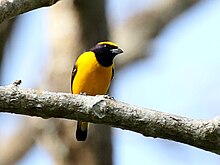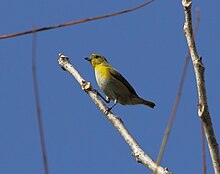
The rufous-tailed jacamar is a near passerine bird which breeds in the tropical New World in southern Mexico, Central America and South America as far south as southern Brazil and Ecuador.

The channel-billed toucan is a near-passerine bird in the family Ramphastidae found on the Caribbean island of Trinidad and in tropical South America as far south as southern Brazil and central Bolivia.

The crested oropendola, also known as the Suriname crested oropendola or the cornbird, is a New World tropical icterid bird. It is a resident breeder in lowland South America east of the Andes, from Panama and Colombia south to northern Argentina, as well as on Trinidad and Tobago. If the genus Gymnostinax for the Montezuma oropendola and its closest relatives were considered valid, this species would probably belong in that genus.

The purple honeycreeper is a small Neotropical bird in the tanager family Thraupidae. It is found in the tropical New World from Colombia and Venezuela south to Brazil, and on Trinidad. A few, possibly introduced birds have been recorded on Tobago.

The golden-olive woodpecker is a species of bird in the subfamily Picinae of the woodpecker family Picidae. It is found from Mexico south and east through Panama, in every mainland South American country except Chile, Paraguay, and Uruguay, and Trinidad and Tobago.

Euphonias are members of the genus Euphonia, a group of Neotropical birds in the finch family. They and the chlorophonias comprise the subfamily Euphoniinae.
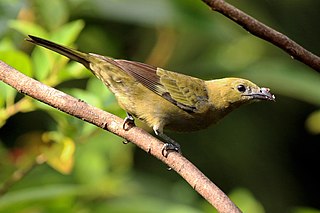
The palm tanager is a medium-sized passerine bird. This tanager is a resident breeder from Nicaragua south to Bolivia, Paraguay and southern Brazil. It also breeds on Trinidad and, since 1962, on Tobago. In Trinidad and Tobago, it is known by colloquial names such as the "palmiste" on American Spanish countries, Brazil Pipira-verde and the "green jean" in American English.

The silver-beaked tanager is a medium-sized passerine bird. This tanager is a resident breeder in South America from eastern Colombia and Venezuela south to Paraguay and central Brazil, Peru and on Trinidad. It is common and conspicuous.

The speckled tanager is a medium-sized passerine bird. It is a resident breeder in Costa Rica, Panama, Trinidad, Venezuela, Colombia, Guyana, Suriname and the extreme north of Brazil. There are also sight records from French Guiana.
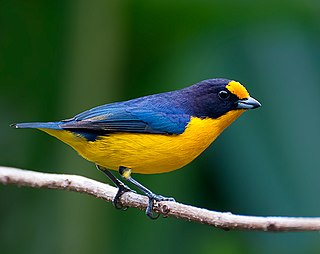
The violaceous euphonia is a small passerine bird in the true finch family Fringillidae. It is widely distributed in eastern South America.
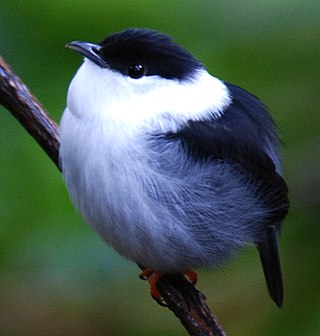
The white-bearded manakin is a small passerine bird which breeds in tropical South America. It can be found in Colombia, Venezuela and Trinidad south to Bolivia and northern Argentina. This manakin is found in forests, secondary growth and plantations. It is a small, plump bird about 10.7 centimetres (4.2 in) long. Males have a black crown, upper back, wings and tail and are otherwise white. Females are olive-green and resemble female golden-headed manakins. At breeding time, males are involved in lekking behaviour on the forest floor during which they puff out their neck feathers. This is a fairly common species with a wide range, and the International Union for Conservation of Nature has rated its conservation status as being of "least concern".

The white-throated spadebill is a tiny passerine bird in the tyrant flycatcher family. It lives in the tropical Americas.

The forest elaenia is a small passerine bird in the tyrant flycatcher family. It breeds from Panama through Colombia, Venezuela and the Guianas to Bolivia and Brazil. It also occurs on Trinidad.

The scaled pigeon is a large New World tropical dove. It is a resident breeder from southern Mexico south to western Ecuador, southern Brazil, northern Argentina, and Trinidad.

The caciques are passerine birds in the New World blackbird family which are resident breeders in tropical South America north to Mexico. All of the group are in currently placed in the genus Cacicus, except the aberrant yellow-billed cacique, and the Mexican cacique which constitute respective monotypic genera. Judging from mitochondrial DNA cytochrome b and NADH dehydrogenase subunit 2 sequence, the aberrant oropendolas band-tailed oropendola and casqued oropendola, Psarocolius oseryi seem to be closer to the caciques.

The plushcap is a species of bird in the tanager family Thraupidae and it is the only member of the genus Catamblyrhynchus.
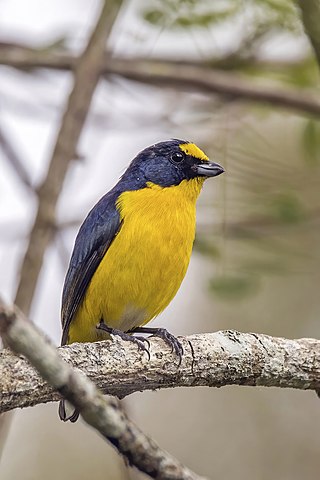
The yellow-throated euphonia is a species of songbird in the family Fringillidae. It is found in southeastern Mexico and throughout Central America with its range stretching from Belize south to western Panama. It inhabits primarily both humid and dry regions where it prefers the forest edge, open woodland, and shaded plantations. It has two subspecies, the nominate subspecies Euphonia hirundinaceahirundinacea and Euphonia hirundinacea gnatho. This finch is a small bird with pointed wings and a short bill and short tail. Males of this species have dark glossy blue-black upperparts excluding a yellow forecrown, and bright yellow underparts, while females have olive green upperparts and whitish-gray breast and lower parts. It has a shrill song that alternates between high-pitched and moderately pitched and appears to be able to mimic some calls of other birds.

The Jamaican euphonia is a species of bird in the family Fringillidae. Jamaican euphonias are small and have a varying appearance depending on their gender and age. They are the only species of Euphonia that reside in Jamaica and have received the nickname of “Short-Mouth Bluequit” from Jamaican locals. These birds do not migrate anywhere and can be found throughout the island in wooded areas, shrublands, gardens, orchards, and hilly lowlands.
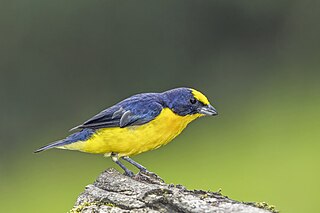
The thick-billed euphonia is a species of bird in the family Fringillidae, formerly placed in the Thraupidae.

Ramphocelus is a Neotropical genus of birds of the tanager family. They have enlarged shiny whitish or bluish-grey lower mandibles, which are pointed upwards in display. However, this is greatly reduced in the females of most species. Males are black and red, orange or yellow, while females resemble a duller version of the males, or are brownish or greyish combined with dull red, orange or yellowish.
